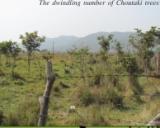A GOOD DEED ..... NEGATED
Tree Plantation at Choutaki in dire need of support
 Their hard labour and determination shot their ancestral village Choutaki into Guinness Book fame on July 20th, 2008. After about three and half years the villagers of Choutaki are facing the toughest ever challenge to sustain Choutaki’s fame and their cherished dream of generating the world’s manmade forest of 2.80 lakh trees.
Their hard labour and determination shot their ancestral village Choutaki into Guinness Book fame on July 20th, 2008. After about three and half years the villagers of Choutaki are facing the toughest ever challenge to sustain Choutaki’s fame and their cherished dream of generating the world’s manmade forest of 2.80 lakh trees.
When the unique efforts of villagers of Choutaki, belonging to Koch-Rajbongshi and Nath-Jogi communities of Srijangram development block in North Salmara sub-division of Bangaigaon district in lower Assam, of planting 2.84 lakh saplings in an area of 34 hectares of land in just 24-hours set a new record to include the village’s name in the Guinness Book of World Records- it was not only an eye-opener initiative for green-lovers, but also encouraged many others to undertake such initiatives in abandoned and degraded lands in their respective areas.
The saplings were planted with the help of the local administration, covering nine different plots of 34 hectares of land. This land was part of 852 bighas (nearly 7 bighas constitute one hectare) ancestral grazing land of the village on the bank of Kunjiya river. The programme was implemented under the Mahatma Gandhi National Rural Employment Guarantee Act (MNREGA) with a labour force of 1361 skilled, 3875 semi-skilled and 21,428 unskilled man-days. The cost of the project was `34,73,000 which included preparation of the ground and erection of fencing to protect the plantation.
Saplings of over forty different varieties, including fruit bearing trees as well as timber yielding trees were planted under the programme with the objective of employment generation through MGNREGA, as well as future investment for the villagers. Most of the villagers are agriculturists by occupation.
Now nearly three and half years later, even as most of the saplings are growing, people of Choutaki are facing a Herculean task in achieving the final goal of maintaining the world record as well as their go-green initiative as 30 per cent of these saplings are either withered or have died, thereby reducing the actual number of the trees to a large extent.
 Dayal Nath, Secretary of the Choutaki Village Grazing Reserve Protection cum Development Committee, says the withering and dying of the saplings is not because of human activities but due to natural courses and monsoon flood. Stating that the villagers are willing to regenerate the area again, the Secretary, however, expresses his concern over an indifferent attitude on the part of the administration for the regeneration process. Watering of the plants is a major problem, particularly during winter, which too, led to the withering of some plants, he says.
Dayal Nath, Secretary of the Choutaki Village Grazing Reserve Protection cum Development Committee, says the withering and dying of the saplings is not because of human activities but due to natural courses and monsoon flood. Stating that the villagers are willing to regenerate the area again, the Secretary, however, expresses his concern over an indifferent attitude on the part of the administration for the regeneration process. Watering of the plants is a major problem, particularly during winter, which too, led to the withering of some plants, he says.
“Five months ago, the committee received `1.80 lakh from the administration for replacement of wooden posts of the fencing. However, for regeneration of the withered saplings, we are yet to receive any response from any agencies,” Nath says.
The villagers are keen to save the trees and a 10- member team of the 51-member Committee, regularly makes a visit to the plantation area each Sunday to ensure protection of the saplings. The paddy fields of the village too are near the plantation which helps in regular monitoring of the area, he adds.
The villagers, in fact, have traditionally their own practice of preservation of trees growing in their ancestral grazing land. They impose a penalty of `500/ on each person who fells trees from the grazing land. Such practices ensured protection of many such trees.
“One day the then sub-divisional (civil) MS Manivannan came to visit us, as part of some development tasks. During his visit we told him about such practices of preserving trees in our village land. He instantly became interested and came up with this idea of plantation in this grazing land. Finally the name of our village found place in the Guinness Book of World Records,” says a proud Nath.
Denying such apprehension of the villagers, however, Mr. Pran Krishna Das, Assistant Planning Officer, (Technical) District Rural Development Agency, says that the during the plantation of the saplings at the plot, it was considered that a small number of them would be withered due to natural process.
To help the villagers in their preservation activities, he says the local administration has installed a low-smoke brick-factory near the plantation area to produce bricks, which will ultimately be used in soling of the gravel road in the grazing land, and other village roads of the GP, engaging village people through MNREGA.
This is, Das says, aiming at employment generation of the village people as well as producing assets at village level ensuring cost-effectiveness of village level development activities. The earth which is required for the brick-factory has been collected from a nearby plot, which too, will be developed as the village fishery in the future.
The senior official also says that the administration is also preparing a plan for tourism development in the plantation area. The small river Kunjia, is just another attraction to make the place a tourist-destination. The plan, however, is still in the initial stage, he adds.


